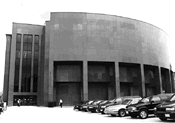
In the Fall of 1995, the City of Chicago officially unveiled the Chicago Emergency Communications Center (CECC), a 161,000-square-foot, state-of-the-art facility that replaced the 9-1-1 center at Police Headquarters. This was the first major renovation of the City’s emergency communications system since 1961.
Located on the 1400 block of West Madison Street on the City’s near West Side, the CECC consolidates emergency communications for police, fire, and emergency medical services. The Center houses 9-1-1 call-taking operations; police, fire, and emergency medical service dispatch operations; and Police Department and Fire Department command and control centers.
The new Center can easily handle 6 million calls a year, with the goal of answering each one within 10 seconds or two rings of the phone. The CECC provides better tracking of calls for police, fire, and emergency medical personnel and cuts critical minutes from their response times. It also permits, for the first time, the use and analysis of data from emergency calls in virtually a real-time mode.
The CECC makes extensive use of fiber optic data transmission and the latest computer technologies, including an advanced mapping system to assist call takers and dispatchers in analyzing the area from which a call was made. Its technical systems are designed for flexibility and for easy, inexpensive upgrades in the future. The Center has an emergency power generator and other backup systems to sustain operations during a power failure or disaster.
In conjunction with the new 9-1-1 system, the Police Department is installing state-of-the-art mobile workstations in more police squad cars and equipping more police officers with hand-held personal data terminals. These devices give officers quicker, more direct access to police records, and provide dispatchers with another mechanism (other than the police radio) to communicate with field personnel.
This building has been designed for high security and built to withstand almost any disaster or emergency. Architecturally, the CECC has been designed to minimize stress on the dispatchers and supervisors who work there. The Center provides a comfortable, high security, stress mitigating work environment, with ergonomic furniture and computer equipment, open spaces and natural light, and separate break and workout rooms.
The CECC will be operated by the Police Department’s Office of Emergency Communication. Eventually, it will be completely staffed by highly trained civilian employees. The Police and Fire Departments will retain their own procedures for taking and dispatching calls, however.
Some of the technical features of the Chicago Emergency Communications Center include:
A speedy, sophisticated 9-1-1 system will answer 99.99% of all service calls in 10 seconds or less.
Computerized mapping and geographic information systems will show on-screen representations of street closures, utility work, and other information that will assist dispatchers in re-routing emergency vehicles.
State-of-the-art text phone technology (TDD) will provide immediate access to 9-1-1 services for the hearing and speech impaired.
Display terminals will automatically show a caller’s phone number and address. This saves time and helps prevents potentially costly errors.
A Computer-Aided Dispatch system will quickly provide historical information about previous calls involving a person or location. This information can alert police officers to potentially dangerous situations before they arrive.
A 176-mile fiber optic network will connect the CECC and all police districts and areas. In the future, this network will provide the necessary backbone to transport arrest histories, case reports, photographs, and other records in a secure and rapid environment.
